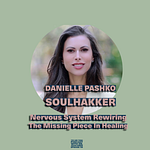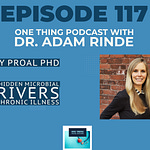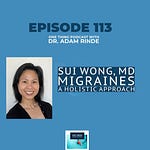In episode 111 of my podcast I interviewed Gillian Ehrlich, DNP, ARNP of NeurovedaHealth, a pioneer in integrative medicine. Gillian shares her unique journey from a Cleveland childhood and outdoor adventures to becoming a leading practitioner blending #Ayurveda, conventional nursing, and functional medicine. She discusses her philosophy of empowering individuals to embrace their unique selves, the challenges of integrating alternative approaches into conventional healthcare, and the innovative treatments offered at NeurovedaHealth, including a blend of ancient practices like PanchaKarma with modern therapies like plasmapheresis and ketamine-assisted psychotherapy.
Listen in and walk away with the following:
Gain a New Perspective on Integrative Medicine: Understand the potential of combining ancient wisdom with modern science for a more holistic and personalized approach to healthcare. Learn how Ayurveda principles can be integrated with conventional treatments to enhance their effectiveness.
Discover Innovative Treatment Options: Explore cutting-edge therapies like plasmapheresis and ketamine-assisted psychotherapy, and how they can be used in conjunction with Ayurveda to address complex chronic illnesses and promote #longevity.
Learn How to Embrace Individuality in Health: Understand the importance of focusing on personal uniqueness rather than adhering to averages or "normal" standards of health. Discover how to empower your own health journey by embracing your specific needs and patterns.
Find Inspiration for Holistic Healing: Learn about Gillian’s personal journey and the challenges she overcame to create an integrative practice. Be inspired to explore alternative and complementary approaches to healthcare, particularly for complex conditions.
Understand the Power of a Unified Approach: For healthcare practitioners, learn about how a unified approach, rooted in Ayurveda or another core philosophy can enhance the integration of modalities. The use of modalities without an underlying philosophy limits their usefulness.
Actionable Insights for Your Health Journey: Gain practical insights into how to approach health from a more holistic and individualized perspective, whether you're a healthcare professional or simply someone seeking to improve their well-being.
Improved Understanding of Neuroplasticity: Grasp the significance of neuroplasticity and how it relates to the process of healing from chronic conditions.
Show notes and timeline
I. Introduction (0:00-1:31)
Gillian Ehrlich, DNP, ARP Introduction (0:00-1:01):
Highlights her background: Doctorate in clinical nursing, specializing in complex chronic illness.
Mentions her integrated approach: Ayurvedic medicine, conventional nursing, functional/integrative medicine.
Describes her use of advanced therapies: ketamine-assisted psychotherapy, plasmapheresis, IV therapies.
Lists conditions she addresses: fibromyalgia, chronic fatigue syndrome, POTS, long COVID, mast cell activation syndrome, PTSD.
Guest Welcome (1:01-1:31):
II. Early Influences (1:31-10:38)
Childhood in Cleveland (1:31-3:16):
Describes growing up in Cleveland, Ohio (late 70s-early 80s) and its polluted environment (Cuyahoga River fire).
Details a standard American diet of the time, and noticing tired adults.
Jane Esselstyn (3:16-4:22):
Introduces Jane Esselstyn, daughter of Dr. Caldwell Esselstyn, as a significant influence from her 10th-grade health class.
Highlights Jane's connection to outdoor education (Outward Bound) and vegan eating.
Notes how Jane's approach to life made a profound impression.
Hypermobility and Outward Bound (4:22-5:31):
Discusses her personal experience with hypermobility (Ehlers-Danlos) and related conditions (POTS, mast cell activation).
Explains how she found physical activity that worked for her (rowing) in Outward Bound.
Reflects on the connection between health and clear perception and living one's clearest life.
Early Adulthood and Exploration (5:31-8:32):
Describes her early interest in health, but dissatisfaction with the medical school model.
Explored outdoor leadership, regenerative agriculture, and community farming (e.g., garlic harvesting and soil chemistry, mushroom cultivation).
Details sailing from Hawaii to San Diego, highlighting a sense of experiencing "retirement in reverse."
Introduction to Ayurveda (8:32-10:38):
Introduces childhood friend Anisha Durve and her role in introducing Jillian to Ayurveda.
Describes attending Ayurvedic classes with Dr. Vasant Lad in Albuquerque.
Notes the effectiveness of Ayurveda in understanding and working with people.
Decides to pursue formal study at the Ayurvedic Institute (2000-2001).
III. Integrating Ayurveda with Western Medicine (10:38-13:48)
Desire for Change (10:38-12:00):
Explains a motivation to bring Ayurvedic insights into Western medicine, similar to Rigoberta Menchu's approach to systemic change through understanding and communicating with the system.
Acknowledges mentorship from key figures: Keesha Ewers, Ilene Ruhoy, and Arti Chandra.
Describes a responsibility to give back due to those blessings.
Challenges in Conventional Systems (12:00-13:48):
Discusses working in primary care settings (Swedish, Harborview) and the limitations for incorporating Ayurveda.
Notes the pressure from insurance companies regarding visit length and scope.
Led to establishing Neuroveda Health where she could practice more freely.
Highlights the freedom in current practice to customize treatments and to address practical needs for patients (e.g. coordinating imaging)
IV. Patient Experiences and Philosophy (13:48-18:11)
Emphasizing Individuality (13:48-16:08):
Stresses the belief that individuals are best when being themselves, rather than aiming for averages or "normalcy."
Focuses on seeing and appreciating the unique ways people can be human, and this is part of the "magic" of the work.
Relates an anecdote about a trans patient who felt seen and accepted.
Role as a Teacher (16:08-18:11):
Describes her role as a teacher, helping patients understand their unique needs.
Emphasizes the importance of relaxation for learning and healing.
Uses humor (swearing, jokes) to help patients feel comfortable and activate the parasympathetic nervous system.
Goal for patients to leave with a sense of their own needs and the tools to address their health.
V. Neuroveda Health and Integrative Approach (18:11-32:04)
Spectrum of Health and Disease (18:11-19:23):
Views complex disease and longevity as being on the same spectrum (related to oxidative stress).
Emphasizes a common approach to both (though treatments vary) involving unwinding underlying processes.
Pancha Karma (19:23-22:04):
Introduces Pancha Karma, a traditional Ayurvedic detoxification system (10,000+ years).
Describes Pancha Karma's components: oilation, specialized treatments, elimination practices
Notes it can be helpful for deep disease and longevity.
Executive Longevity Program (ELP) (22:04-26:38):
Presents Neuroveda's programs, aimed to address both chronic illness and longevity, based on Panchakarma.
Describes the program format: 90-minute intake followed by 3-21 days of services.
Lists offered treatments: Ayurvedic bodywork (Abhyanga, Shirodhara, Nasya), plasmapheresis, IVIG, stem cells, prolotherapy, PRP, ozone, NAD, mitochondrial IVs, Myers cocktails, ketamine-assisted psychotherapy.
Designed for patients to come for a program and then return to their primary providers for continued care.
Diagnostics and Additional Therapies (26:38-28:17):
Discusses available diagnostics: autonomic testing, EDS evaluation, skin biopsies for small fiber neuropathy, alpha synuclein, amyloid.
Manual craniocervical instability testing, electro-stimulation suits, autologous exosomes (require longer stay), vagal nerve stimulation.
Frustrations Leading to the Clinic (28:17-32:04):
Notes that patients often find Ayurveda after exhausting other options and after multiple clinicians
Highlights that many chronic fatigue patients have seen a large number of doctors and tried many therapies.
Emphasizes the need to focus on developing and cultivating neuroplasticity.
VI. Ayurvedic Principles in Practice (32:04-37:53)
Ayurveda as the Foundation (32:04-33:18):
Emphasizes that the core of her practice is rooted in Ayurvedic principles, especially when implementing Western modalities.
Highlights that the various therapies stem from the core Ayurvedic philosophy.
Plasmapheresis and Raktamokshana (33:18-35:25):
Connects plasmapheresis with "Raktamokshana" from Ayurveda which means "the removal of blood".
Mentions the five actions of detoxification (Panchakarma) including Vamana (vomiting), Nasya (nasal oil), Virechana (castor oil), Basti (enemas), and Raktamokshana (bloodletting).
Notes the historical use of bloodletting in various cultures.
Points out that the closer the cutting edge of medicine goes, the closer it is to Ayurveda.
Treatment Personalization and Doshas (35:25-37:53):
Treatment recommendations are based on disease pattern and doshas.
Illustrates the holistic view through a case example of a CRPS patient where Vata was imbalanced (and treatments needed to be very gentle).
Connects Ayurvedic principles of digestion with the body's ability to integrate treatments.
Unique Approach (37:10-37:53)
Notes that other longevity clinics may clump modalities together, but Neuroveda has a unifying platform based on Ayurveda
VII. Closing Thoughts (37:53-39:35)
Clinic Atmosphere (37:53-38:20):
Host notes the positive energy and Seattle vibe of the clinic.
Closing Remarks (38:20-39:35):
Jillian thanks the host for having her on the show, invites him to return anytime.
Encourages listeners to sign up for the Neuroveda Health newsletter for education updates.
Keywords:
Ayurveda
Integrative Medicine
Functional Medicine
Complex Chronic Illness
Pancha Karma
Plasmapheresis
Ketamine-assisted psychotherapy
IV Therapies
Hypermobility
Ehlers-Danlos Syndrome
POTS
Mast Cell Activation Syndrome
Neuroveda Health
Doshas
Vata
Oxidative Stress
Raktamokshana














Share this post